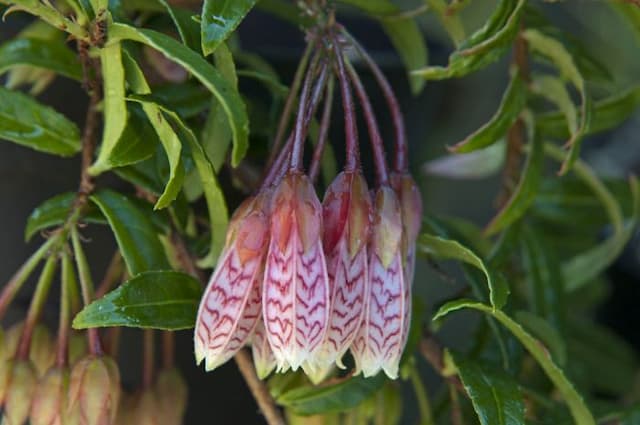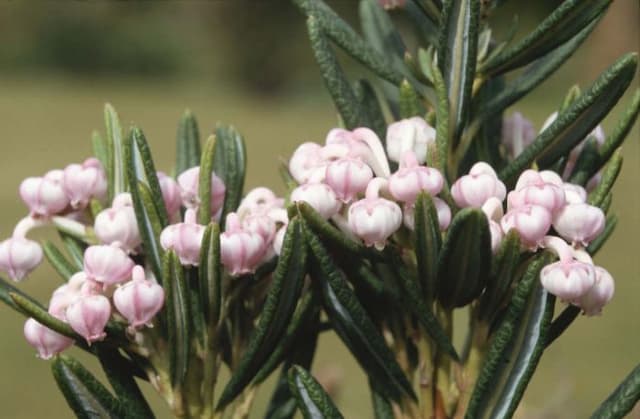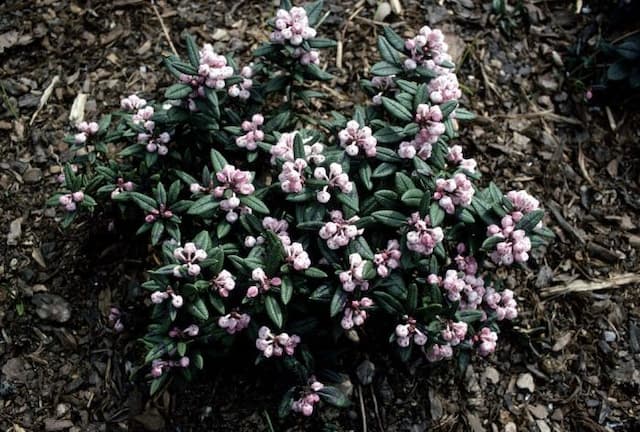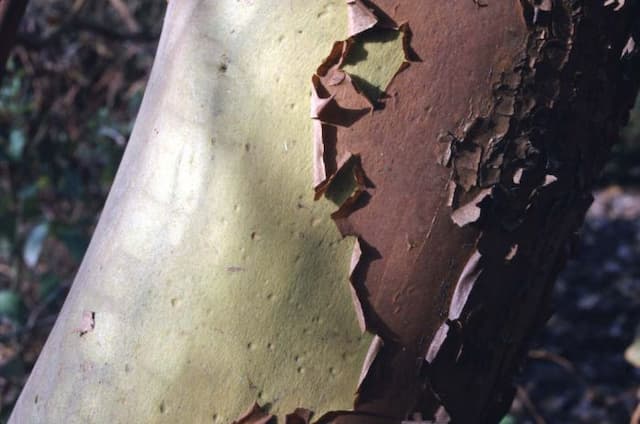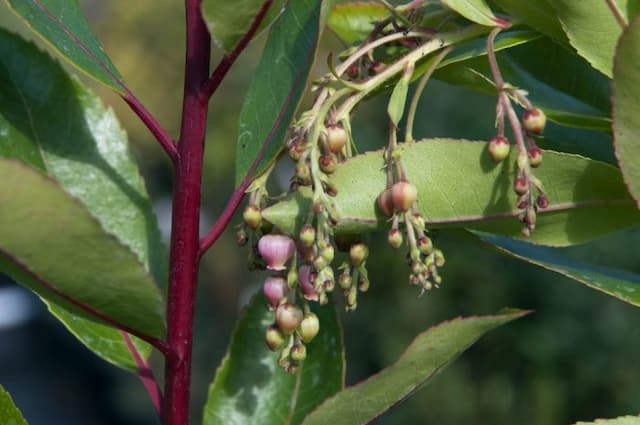Bell Heather Erica cinerea 'Glencairn'










ABOUT
The plant known as Erica cinerea 'Glencairn' presents a striking and picturesque appearance. This species, commonly referred to as bell heather, boasts a rich tapestry of prolific, bell-shaped flowers that capture the eye with their vivid coloration. The flowers typically exhibit a deep purple hue, which add a splash of color to any landscape. These blooms are densely packed and provide a long-lasting display that can charm onlookers throughout their flowering season. Complementing the vibrant flowers is the plant's foliage, which forms a lush backdrop with a fine, needle-like texture. The leaves are small and narrow, presenting a grey-green color that contrasts subtly with the more intense color of the blossoms. This foliage remains evergreen, contributing to the plant's appeal outside of its peak blooming period. Forming a cushion or mat-like shape, the bell heather is elegant yet hardy, with a robust and bushy presence that enables it to thrive and form a dense cover. The overall impression of Erica cinerea 'Glencairn' is of a lively and resilient plant that can brighten and embellish a variety of landscapes with its distinctive charm.
About this plant
 Names
NamesFamily
Ericaceae
Synonyms
Bell Heather, Twisted Heath
Common names
Erica cinerea 'Glencairn'.
 Toxicity
ToxicityTo humans
The common name of Erica cinerea 'Glencairn' is bell heather. Bell heather is generally considered non-toxic to humans. There are no significant reports of poisoning or toxic effects from ingesting this plant. Therefore, it is unlikely to cause harm if accidentally consumed in small quantities.
To pets
Similar to its effect on humans, bell heather is not commonly known to be toxic to pets. It is not listed among plants that are poisonous to dogs, cats, or other domestic animals. Thus, ingestion of bell heather by pets is not expected to result in poisoning or produce harmful symptoms. However, individual animals might have different sensitivities or allergic reactions. It is always a good practice to prevent pets from eating ornamental plants as a cautionary measure.
 Characteristics
CharacteristicsLife cycle
Perennials
Foliage type
Evergreen
Color of leaves
Green
Flower color
Purple
Height
1 foot (30 cm)
Spread
1 foot (30 cm)
Plant type
Shrub
Hardiness zones
5
Native area
Europe
Benefits
 General Benefits
General Benefits- Aesthetic Appeal: Adds color and texture to gardens with its pink to purple flowers and fine, needle-like foliage.
- Habitat Support: Provides nectar for pollinators such as bees and butterflies, enhancing biodiversity.
- Low Maintenance: Once established, it requires minimal care, making it ideal for gardeners seeking low-effort plants.
- Drought Tolerance: Adapts well to dry conditions after establishment, reducing the need for frequent watering.
- Soil Adaptability: Grows well in acidic soils, which can be beneficial for gardeners with this soil type.
- Evergreen: Retains its foliage throughout the year, providing constant greenery and interest.
- Compact Growth: Its small and bushy habit makes it suitable for borders, rockeries, and small garden spaces.
- Deer Resistance: Typically not favored by deer, which helps prevent damage in areas with deer populations.
- Seasonal Interest: Blooms in the summer, offering a splash of color when many other plants have finished flowering.
- Winter Hardiness: Capable of withstanding cold temperatures, making it suitable for gardens in cooler climates.
 Medical Properties
Medical PropertiesThis plant is not used for medical purposes.
 Air-purifying Qualities
Air-purifying QualitiesThis plant is not specifically known for air purifying qualities.
 Other Uses
Other Uses- The bell heather can be used in the creation of a natural dye; its flowers and stems can yield colors from green to yellow, perfect for textiles.
- Dried bell heather is sometimes incorporated into potpourri mixes for its color retention and subtle fragrance.
- The fibrous parts of the plant can be utilized in traditional crafts, such as the making of brooms and small brushes.
- It is used in landscaping to stabilize soil on slopes and prevent erosion because of its extensive root system.
- Bell heather, with its tolerance to wind, is often planted in coastal areas to create windbreaks or as a part of garden designs that aim to mimic natural heathland.
- The subtle, honey-like fragrance of bell heather flowers makes it an excellent addition to natural perfumes and scented sachets.
- Culinary enthusiasts sometimes use the flowers to infuse syrups or sugars, giving them a unique, floral note.
- When planted in gardens, bell heather provides a valuable nectar source for bees and butterflies, making it a choice plant for pollinator-friendly gardening.
- In model making and miniature landscapes, dried bell heather can be used to represent trees or shrubbery due to its small scale and woody appearance.
- Bell heather is also employed in themed garden setups such as fairy gardens due to its dense and colorful foliage that adds an enchanting touch.
Interesting Facts
 Feng Shui
Feng ShuiThe Heather is not used in Feng Shui practice.
 Zodiac Sign Compitability
Zodiac Sign CompitabilityThe Heather is not used in astrology practice.
 Plant Symbolism
Plant Symbolism- Loneliness or Solitude: Erica Cinerea, commonly known as Bell Heather, often grows in barren, isolated places, symbolizing seclusion or the beauty of solitude.
- Protection: Bell Heather has been traditionally used as a protective charm against harm and negativity in various cultures.
- Admiration: With its delicate pink, purple, or white flowers, Bell Heather can symbolize admiration for someone's beauty or grace.
- Good Luck: In some regions, Bell Heather is seen as a token of good fortune, particularly when carried by brides or used in weddings.
- New Beginnings: The perennial nature of Bell Heather and its resilience in harsh environments is often associated with starting afresh or overcoming challenges.
 Water
WaterThe Bell Heather should be watered thoroughly, making sure to deeply soak the soil, as this plant prefers well-drained but consistently moist conditions. During active growth in the spring and summer, water approximately once a week with about 1 gallon per plant, depending on climate and soil conditions. During the fall and winter, reduce watering to every other week or less, depending on rainfall, as the plant has lower water requirements when it is not in active growth. Be cautious not to overwater as Bell Heather dislikes waterlogged soil, which can lead to root rot.
 Light
LightBell Heather thrives best in full sunlight, meaning it should receive at least six hours of direct sunlight daily. An ideal spot would be in a south-facing garden where it can benefit from maximum light exposure throughout the day. If planted indoors, a south-facing window with ample light or a sunroom would be most beneficial for healthy growth.
 Temperature
TemperatureBell Heather is hardy and can tolerate a wide range of temperatures; it prefers cooler climates and can survive minimum temperatures down to about 20°F. However, for optimal growth, maintain an environment where the temperature stays between 60°F and 70°F. Extreme heat above 75°F can stress the plant, so it should be offered some protection during the hottest parts of the day.
 Pruning
PruningBell Heather should be pruned to maintain shape, encourage new growth, and prevent it from becoming leggy. The best time to prune is in late winter or early spring, just before new growth starts. Prune lightly, not more than one-third of the plant, to keep a compact form and stimulate bushier growth. Regular pruning also helps to promote more abundant flowering for the next season.
 Cleaning
CleaningAs needed
 Soil
SoilBell heather (Erica cinerea 'Glencairn') thrives in well-drained, acidic soil with a pH between 4.5 and 5.5. A soil mix consisting of peat moss, sand, and loamy soil in equal parts can provide the right conditions for growth. Fertilization should be minimal as the plant prefers nutrient-poor conditions.
 Repotting
RepottingBell heather should be repotted every 2 to 3 years to refresh the soil and accommodate root growth. It's best to repot in the spring before the plant enters its active growing phase.
 Humidity & Misting
Humidity & MistingBell heather prefers moderate humidity levels, avoiding excessively dry or damp conditions. Aim for humidity that mimics its natural heathland habitat without the need for misting or special humidity control.
 Suitable locations
Suitable locationsIndoor
Provide bright light, acidic soil, and good drainage.
Outdoor
Full sun, acidic soil, protect from harsh winter winds.
Hardiness zone
4-9 USDA
 Life cycle
Life cycleBell Heather 'Glencairn' begins its life as a seed, which requires well-drained, acidic soil and exposure to sunlight to germinate, typically occurring in spring or early summer. After germination, the seedling phase involves root and shoot development as the plant establishes itself. The vegetative stage follows, during which the plant develops a woody base and needle-like leaves, continuing to grow and spread. Flowering occurs in summer, with 'Glencairn' producing distinctive purple flowers that attract pollinators and facilitate cross-pollination. After pollination, seed set takes place, and once seeds mature, they are dispersed by wind or wildlife, ready to initiate a new generation. The plant can live for several years, with vegetative growth and flowering occurring annually during its perennial life cycle.
 Propogation
PropogationPropogation time
Summer
The most popular method for propagating Erica cinerea 'Glencairn', commonly known as bell heather, is through semi-hardwood cuttings. This typically occurs in late summer or early autumn after flowering when the new growth has begun to mature. To propagate, one would cut a piece of semi-hardwood stem approximately 2 to 4 inches (5 to 10 centimeters) long, making sure there are at least a couple of leaf nodes present. The lower leaves are removed, and the cut end of the cutting can be dipped in rooting hormone to encourage root development. The cutting is then placed in a well-draining soil mix, ensuring that the leaf nodes are buried. It is essential to maintain a humid environment, often by covering the cuttings with a plastic bag or placing them in a propagator, and keeping them under indirect light until they root. With proper care, roots typically develop within a few weeks.
